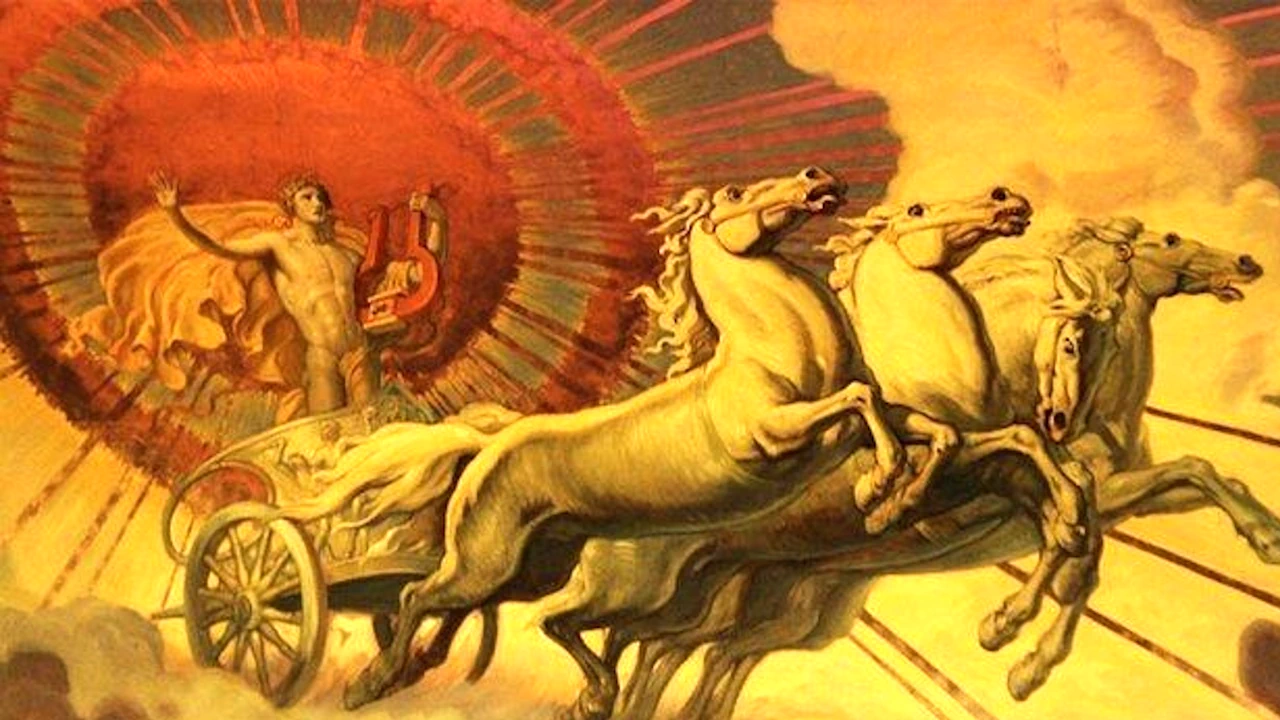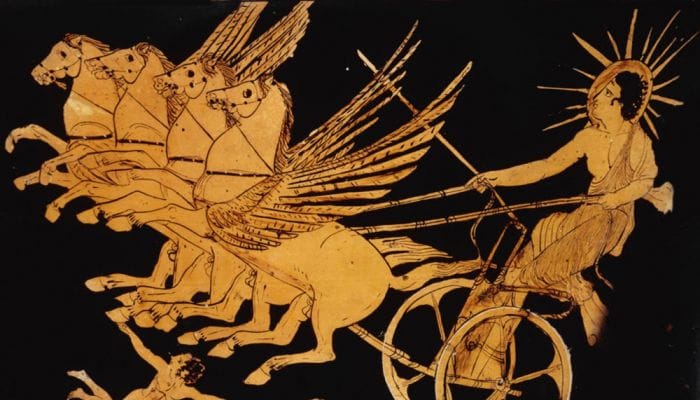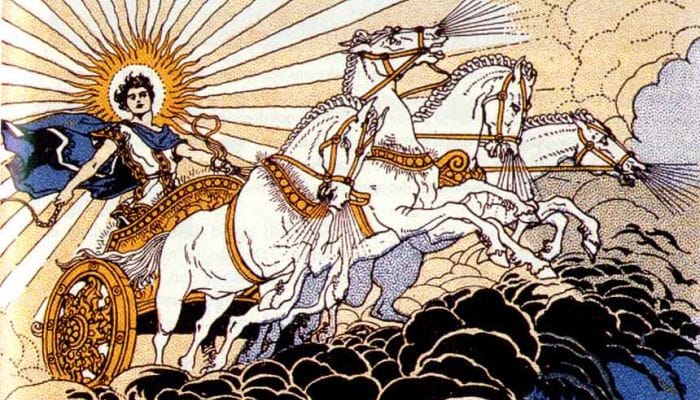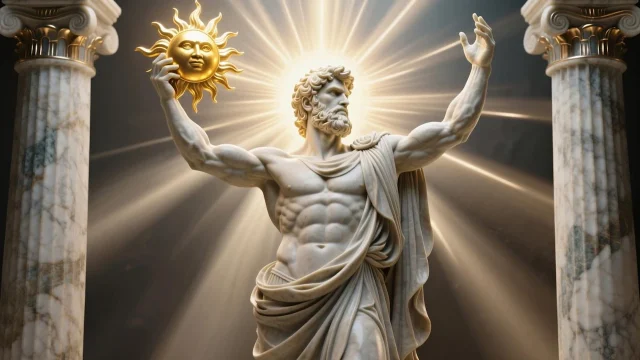Learn about the legend of Helios, the Titan of the Sun in Greek mythology. Discover his most popular exploits and myths.

Helios: Titan of the Sun
Helios is the Greek god of the Sun, whom the Romans called Sol. Most of the time, people saw or portrayed him as a powerful charioteer, driving his flaming chariot (or gleaming horses) from east to west across the sky every day. At night, according to legend, he crossed to the east floating in a golden cup over the stream of the Ocean, the mythical river that was thought to surround the plain of the earth.
Because he was in the sky all day looking down on the earth, people assumed that he saw and heard everything that happened in that domain; therefore, both gods and humans called on him as a witness to various events or sworn oaths. He was usually depicted as a beardless, very handsome man wearing purple robes and crowned with a golden halo, which accentuated his role as the Sun God. His characteristic chariot was pulled by four winged horses.
Who was Helios?
He was one of the Titans, son of Hyperion and Theia, and brother of Eos (the Dawn) and Selene (the Moon). The personification of the Sun, he was portrayed as driving a four-horse chariot across the sky every day. Helios was married to Perse, but he had many extramarital affairs and several children, including the Charites, Phaethon, Circe, Aeetes, Pasiphae, and the Heliades. Later, Helios merged with Apollo; to the Romans, he was known as Sol.
Family
The Greek god of the sun was the only son of the Titans Hyperion (“The High One”) and Theia (“divine”; sometimes also called Eurifassa, the “shining one”). The couple also had two daughters: the “rich” Selene and the “rosy” Eos, who represent, respectively and appropriately, the Moon and the Dawn.

Representation
The image of Helios driving his four-horse chariot with “golden yoke,” sometimes accompanied by his sisters, is one of the most recognizable images in all of Greek art. “As he rides in his chariot, the poet of the 31st Homeric hymn writes beautifully about him, he shines upon men and immortal gods, and gazes with piercing eyes from his golden helmet. His bright rays shine dazzlingly from him, and his shining locks sprouting from the temples of his head gracefully enclose his distant face: a rich and fine garment shines on his body and flutters in the wind; and the stallions carry him.”
Initially described collectively as “dancing steeds of fire,” the four horses would later be given names related to the sun: Pyrois (“the incendiary”), Eous (“belonging to the dawn”), Aethon (“burning”), and Phlegon (“burning”).
The wives of Helios and his children
Helios was married to Perse, but like many other male gods, he had many known affairs, most notably with Clymene, Rhode, and Leucothoe.
Perse
According to most accounts, Helios was married to the Oceanid Perse (or Perseis), with whom he had at least four children: Aeetes and Persas, both kings of Colchis at different times; Pasiphae, the wife of Minos and mother of the Minotaur; and Circe, the powerful sorceress of Aeaea.
Clymene
Possibly his most famous lover was the Oceanid Clymene, with whom he had three (or, some say, five) daughters known collectively as the Heliades, and a son named Phaeton.
Once, after Helios granted him permission to borrow his chariot for a day, the inexperienced Phaeton lost control of it and had to be killed with a thunderbolt by Zeus, lest he set the whole earth on fire.
Phaeton’s sisters, the Heliades, mourned their brother’s death for so long that, over time, their tears turned to amber and they themselves turned into poplar trees.
Rhode
Rhode was the nymph of the island of Rhodes, which she claimed as her own even before it was created, being the first to see it rising magnificently from the sea. Shortly thereafter, the Sun God lay with Rhode, who bore him seven sons, the Heliadae, and a daughter, Electryone. The Heliadae surpassed all men in both strength and knowledge (especially in astrology) and soon came to rule Rhodes, whose three main cities (Ialysos, Cameiros, and Lindos) are named after some of their sons to this day.
Myths of Helios
Leucothoe and Clytie. Traveling across the sky from sunrise to sunset every day, Helios could see and hear everything that happened during most of the day; naturally, this sometimes meant that he was able to notice things that others preferred to keep as the highest of secrets. Such was the case when he discovered Aphrodite’s affair with Ares, the revelation of which led to the humiliation of both deities.
Aphrodite decided to take revenge, so she made Helios (who was happily with Clytie at the time) fall madly in love with Leucothoe, the daughter of the Persian king Orchamus and Eurynome. Enchanted by Leucothoe’s beauty, Helios disguised himself as her mother and managed to enter her room, after which he changed his form back to his usual beauty, leaving Leucothoe speechless and inspiring her love.

Wanting Helios for herself and unable to bear the pain of his new adventure, Clytie spread the story of someone who had secretly defiled Leucothoe until it reached the ears of Orchamus. The king would hear no excuses: he buried his daughter alive in the cold earth as soon as he found her.
Revive
He quickly discovered her and tried to revive her with the heat of his rays, but it was too little, too late: Leucothoe was dead forever. “Nothing shall prevent you from reaching the heavens,” Helios exclaimed in anger and pain, and transformed Leucothoe into the tree that gives incense.
Clitia hoped that by removing Leucothoe from history, she could win back Helios’ love; instead, she managed to earn his utmost hatred. As he stopped paying attention to her, she began to waste her time in sadness, sitting alone, far from her sister Nymphs and turning her face toward the Sun God constantly in the hope of a single glance. Eventually, she died, and her body was transformed into the heliotrope, whose flowers follow the sun throughout the day.
Helios in other myths
This god did not play an important role in Greek mythology, as he was eventually replaced by Apollo. However, he appears as an extra in the myths of other gods and mortals.
Helios, the Helper
Helios is the one who tells Demeter that her daughter Persephone has been kidnapped by Hades. He is also the one who restores the sight of Orion the Giant. After his granddaughter Medea murders her children, he lends her his chariot so she can escape from Corinth. He also lends his golden bowl to Heracles to help the hero cross the River Ocean and collect Geryon’s cattle.
Helios, the Antagonist: Odysseus
Traveling back from the Trojan War, Odysseus and his surviving crew land on the island of Trinacio, sacred to the Sun God. Hungry and lacking food, against Odysseus’ best advice, his men decide to kill some of Helios’ animals and eat them. Enraged, he complained to Zeus and threatened to take the sun with him and make it shine in the Underworld so that the perpetrators would not be punished. Thus, Zeus sent a violent storm that destroyed Odysseus’ ship, killing all his men except him, as he had not participated in the sacrilege.
Sources
The 31st Homeric Hymn is dedicated to Helios, whose genealogy is found in the Theogony; Hesiod also names the children of Helios with Perse. In his seventh Olympic Ode, Pindar tells the story of Helios and Rhode. In “Metamorphoses,” Ovid beautifully recounts both Helios’ romance with Leucothoe and the plight of their son Phaethon.

